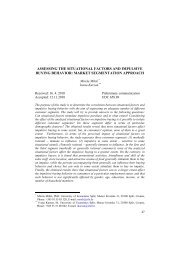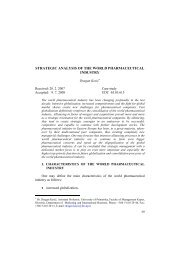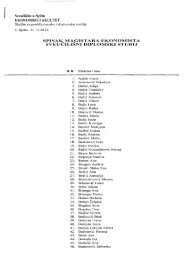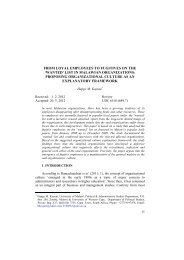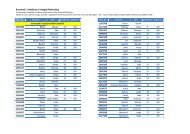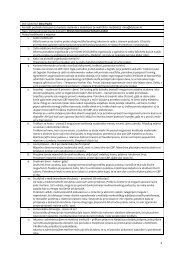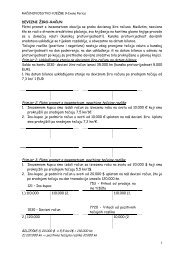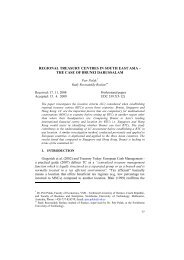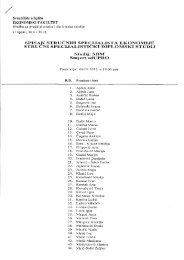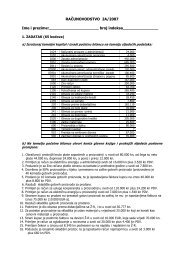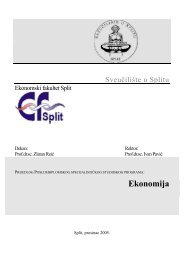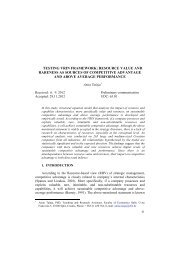Case study: Downsizing strategy influence on the structure of the firm
Case study: Downsizing strategy influence on the structure of the firm
Case study: Downsizing strategy influence on the structure of the firm
You also want an ePaper? Increase the reach of your titles
YUMPU automatically turns print PDFs into web optimized ePapers that Google loves.
Management, Vol. 17, 2012, 1, pp. 75-92<br />
A. H. de E. E. de los M<strong>on</strong>teros, C. S. Bravo: <str<strong>on</strong>g>Case</str<strong>on</strong>g> <str<strong>on</strong>g>study</str<strong>on</strong>g>: <str<strong>on</strong>g>Downsizing</str<strong>on</strong>g> <str<strong>on</strong>g>strategy</str<strong>on</strong>g> <str<strong>on</strong>g>influence</str<strong>on</strong>g> <strong>on</strong> <strong>the</strong> …<br />
• Retrenchment or cost reducti<strong>on</strong>: <strong>the</strong> <str<strong>on</strong>g>strategy</str<strong>on</strong>g> is based <strong>on</strong> improving<br />
productivity by reengineering processes, product c<strong>on</strong>centrati<strong>on</strong> and<br />
redundant work eliminati<strong>on</strong> (Feeman & Camer<strong>on</strong>, 1993).<br />
• Downscaling: this <str<strong>on</strong>g>strategy</str<strong>on</strong>g> maintains <strong>the</strong> activities <strong>of</strong> <strong>the</strong> company, but<br />
reduces <strong>the</strong> output level to suit <strong>the</strong> demand. This means reducti<strong>on</strong>s <strong>of</strong><br />
human and physical resources, sacrificing <strong>the</strong> benefits <strong>of</strong> scale for<br />
adapting to demand cycles (Kotler, 1986).<br />
• Downscoping or Refocusing: reduces <strong>the</strong> scope <strong>of</strong> activity by<br />
decreasing vertical or horiz<strong>on</strong>tal differentiati<strong>on</strong> (Johns<strong>on</strong>, 1996;<br />
Markides, 1995).<br />
To select <strong>the</strong> downsizing <str<strong>on</strong>g>strategy</str<strong>on</strong>g>, three factors should be analyzed: <strong>firm</strong><br />
resources, investment, and activity field. Firm resources can create competitive<br />
advantages, but <strong>the</strong>y also reduce <strong>the</strong> mobility and exit <strong>of</strong> <strong>the</strong> industry. Thus, a<br />
downsizing <str<strong>on</strong>g>strategy</str<strong>on</strong>g> could be satisfactory if selling resources at <strong>the</strong> market<br />
generate more value than keeping <strong>the</strong>m in <strong>the</strong> organizati<strong>on</strong>. Sec<strong>on</strong>d, if <strong>the</strong><br />
company has made recent investments in capacity or products, it is possible to<br />
achieve higher revenues (Caves & Porter, 1976), but it also limits <strong>the</strong> scope<br />
reducti<strong>on</strong> <str<strong>on</strong>g>strategy</str<strong>on</strong>g>, so a retrenchment approach is more likely. Finally, if <strong>the</strong><br />
company has wide fields <strong>of</strong> activity, factors related to business are more<br />
important than <strong>the</strong> industrial <strong>on</strong>es.<br />
Depending <strong>on</strong> <strong>the</strong> specific objectives pursued, <strong>on</strong>e will select <strong>on</strong>e <strong>of</strong> <strong>the</strong><br />
resource reducti<strong>on</strong> strategies (Gresov, 1989, Drazin & Van de Ven 1985). Thus,<br />
<strong>the</strong> Retrenchment is more likely when a <strong>firm</strong> has not invested in <strong>the</strong> capacity<br />
and product and tries to take advantage operating at maximum capacity, or<br />
when competitors have made investments Downscaling involves <strong>the</strong> removal <strong>of</strong><br />
large factories, so it will be d<strong>on</strong>e when <strong>the</strong> company has a wide field <strong>of</strong> activity<br />
and has not invested in <strong>the</strong> product or capacity, or in case <strong>of</strong> fall in demand.<br />
Downscoping reduces <strong>the</strong> variety or output produced, so it is more effective if<br />
<strong>the</strong> company has a wide field and has not recently invested in capacity.<br />
The fit c<strong>on</strong>cept has been a central idea in <strong>the</strong> success <strong>of</strong> organizati<strong>on</strong>s<br />
(Nadler & Tushman, 1988). Following <strong>the</strong> system approach, organizati<strong>on</strong>al fit<br />
occurs when <strong>the</strong> organizati<strong>on</strong>al design balances all <strong>the</strong> c<strong>on</strong>textual factors <strong>of</strong> <strong>the</strong><br />
organizati<strong>on</strong> and its internal variables. Thus, with <strong>the</strong> Nadler and Tushman<br />
model, organizati<strong>on</strong>al effectiveness is due to <strong>the</strong> adjustment <strong>of</strong> its comp<strong>on</strong>ents.<br />
77



